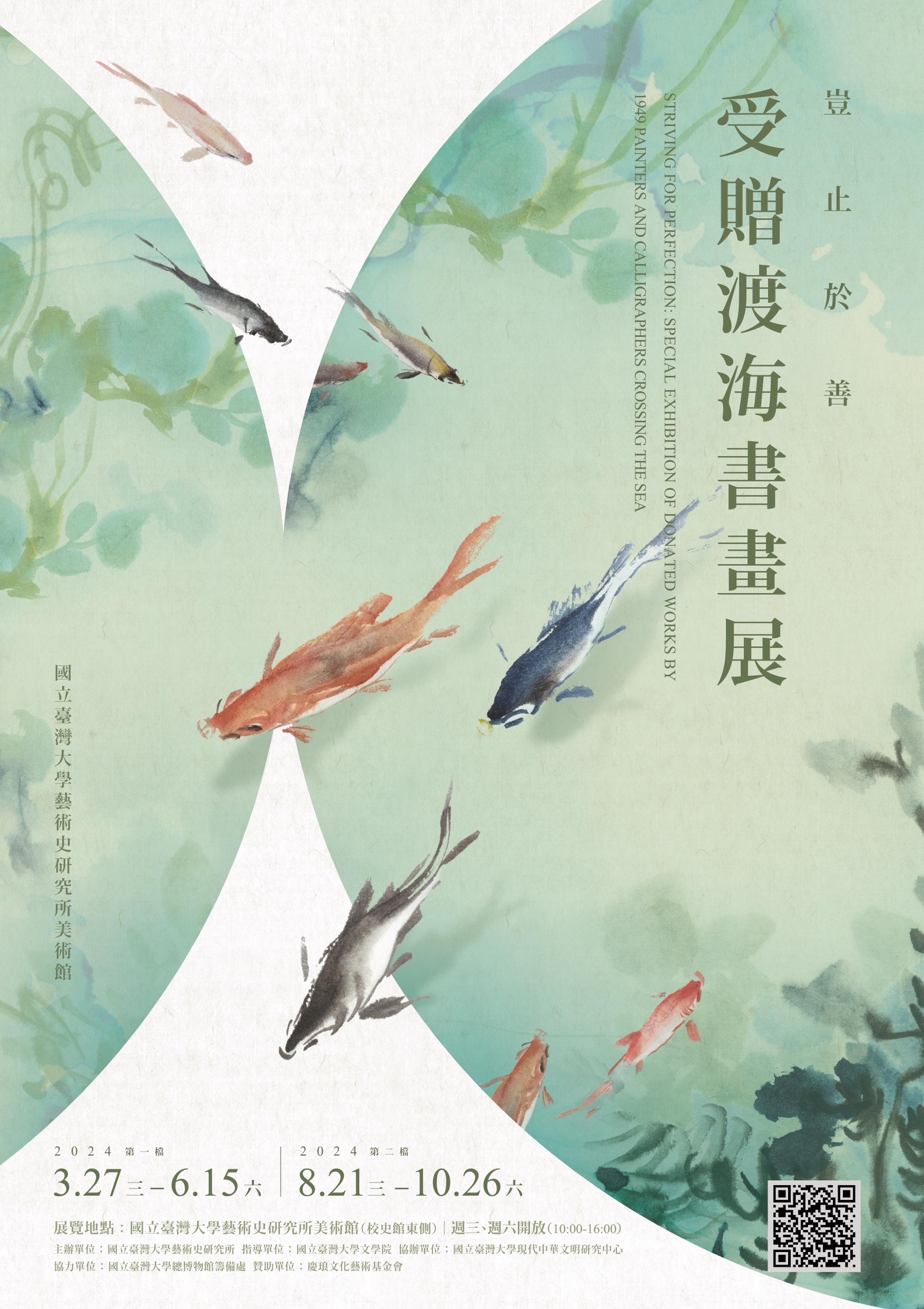豈止於善—受贈渡海書畫展 Striving for Perfection

豈止於善—受贈渡海書畫展
Striving for Perfection: Special Exhibition of Donated Works by 1949 Painters and Calligraphers Crossing the Sea
展出地點 Venue :國立臺灣大學美術館(校史館東側)NTU Art Museum
展出時間 Dates :(1)2024/03/27-06/15;(2)2024/08/21-2024/10/26
策展人 Curators:盧慧紋(國立臺灣大學藝術史研究所教授) Hui-Wen Lu (Professor, Graduate Institute of Art History, NTU)
林珮菱(國立臺灣大學藝術史研究所博士生) Pei-Ling Lin (PhD student, Graduate Institute of Art History, NTU)
展覽資訊 Details: https://arthistory.ntu.edu.tw/artmu/artmu02/20240327/artmu_02_20240327.html
1949年國民政府遷臺,一同渡海而來的還有許多藝文領域名家,與在地的多元傳統相遇,鑄成當今臺灣的文化樣貌。本次展覽含括近40位渡海書畫家超過50組件的作品。他們當中有如溥儒(1896-1963)、黃君璧(1898-1991)、臺靜農(1902-1990)、王壯為(1909-1998)及江兆申(1925-1996)等專精書畫的名家大師;也有如錢大鈞(1893-1982)、宋鍔(1899-1976)、譚伯羽(1900-1982)、陳雪屏(1901-1999)等兼擅藝文的政治、軍事及教育界人士。他們公餘之暇從事詩書畫創作,並以此在聚會雅集中交流情感。
此次展出的書法作品大多為友朋間的酬唱互贈,篆、隸、楷、行、草各體皆備,而以行草書佔大多數。他們或抄錄古人及自作詩文成卷軸,或集古人詩詞書成對聯。他們為動盪時局發出喟嘆,也在藝文中馳騁才情與抒發鄉愁。書家廣泛涉獵古代書史典範,且多兼習帖派與碑派傳統。行草書法風格多取法東晉二王、宋人蘇軾、米芾及晚明米萬鍾、倪元璐等書家,再結合碑版金石書法的厚實用筆,因而兼有典雅閒逸與氣魄雄強的意趣。繪畫方面,他們繼承文人畫的美學取向,所繪題材以四君子及山水為主,畫風受清初四僧、四王等畫家影響頗深。亦常見結合西方繪畫技巧,以表現自然物象的量感、通透感與空間感之嘗試。
這批展品數量雖不大,但頗能展現戰後臺灣書畫之時代風貌。透過此次展覽,我們希望呈現渡海書畫家的豐富面相,也由之窺見藉詩文書畫串起的緊密人際網絡、深厚情誼及對當時藝壇的深遠影響。
此批展品原為袁守謙(字企止,1903-1992)先生之私人收藏。感謝藝術家袁旃(1943-)女士慷慨捐贈本館此批珍貴的家族收藏。
In 1949, when the Nationalist government relocated to Taiwan, many renowned artists and scholars also made their journey across the sea. They encountered Taiwan’s diverse traditions and jointly contributed to shaping Taiwan’s artistic landscape as it stands today. This exhibition presents over 50 works by nearly 40 painters and calligraphers who arrived in Taiwan during that period. Among them are masters of calligraphy and painting, such as Pu Ru (1896-1963), Huang Chun-pi (1898-1991), Tai Chin-nung (1902-1990), Wang Chuang-wei (1909-1998), and Chiang Chao-shen (1925-1996). Also, there were prominent figures in the fields of politics, military, and education who were proficient in arts, including Chien Ta-chun (1893-1982), Sung E (1899-1976), Tan Po-yu (1900-1982), and Chen Hsueh-ping (1901-1999). These individuals worked in public service roles while pursued their interests in poetry, calligraphy, and painting. Through these artistic activities, they bonded with others during literati gatherings.
In the realm of calligraphy, these artists drew inspirations from a wide range of ancient calligraphic models. They were well versed in both the Model book Studies and Stele Studies traditions. The exhibition features works in various scripts including seal script, clerical script, regular script, running script and cursive script. Notably, semi-cursive script dominates the exhibits likely because many of these works were created for social exchanges during literati gatherings. Some artists meticulously copied ancient calligraphy works, some composed poetry and prose to create scrolls, while others compiled classic verses to form couplets. Through art and literature, they lamented the turbulent times and showed their nostalgia for homeland. Their calligraphy styles drew from the works of celebrated calligraphers across history, including Two Wangs from the fourth century, Su Shi and Mi Fu from the 11th-century, and Mi Wanzhong and Ni Yuanlu from the 17th-century. Blending fine brush techniques with the style of bronze and stele inscriptions by anonymous writers from as ancient as the 11th-century BCE to the third century, their calligraphy exuded both elegance and vigor. In the realm of painting, they inherited the aesthetics of traditional literati painting. Their subjects primarily revolved around the Four Gentlemen and landscapes, Influenced by painters like the Four Monks and the Four Wangs from the 17th- and 18th-centuries. Some of them also experimented with Western painting techniques to convey a sense of air, volume, and space in their depictions of nature.
While the quantity of exhibited works may be modest, they effectively represent the era of traditional Chinese calligraphy and painting in Taiwan after World War II. Through this exhibition, we aim to showcase the diverse facets of these artists who crossed the sea from Mainland China to Taiwan, as well as explore the intensive interpersonal networks and deep friendships, interwoven through poetry, literature, and art.
These exhibits originally belonged to the private collection of Mr. Yuan Shou-chien (style name Chi-chih, 1903-1992). We extend our gratitude to Ms. Yuan Jai (1941-), herself a distinguished artist, for generously donating this precious family collection to our museum.
